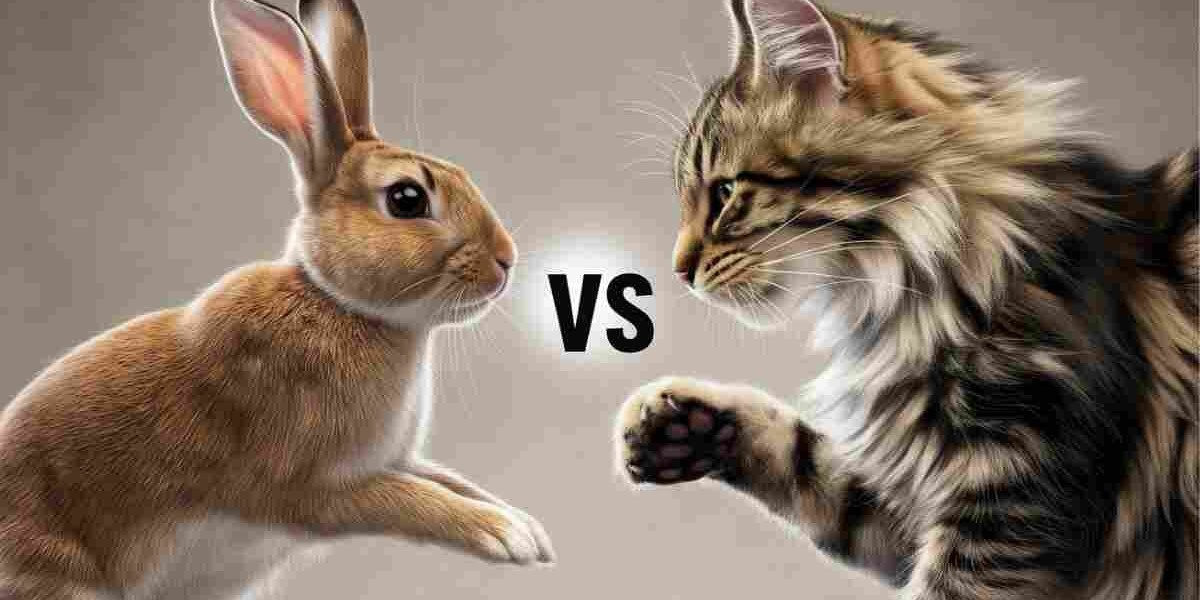Cats and rabbits may be adorable, but they have different histories, behaviors, and care needs! Did you know cats were domesticated 10,000 years ago, while rabbits became pets much later? From diet to speed, social habits to intelligence, discover how these two beloved pets compare—and which one might be the perfect fit for your home!
When Were Rabbits and Cats First Domesticated?
Rabbits and domestic cats have very different stories about becoming our pets. Wild rabbits were first domesticated around the 5th century AD in southern France. Monks helped by breeding them for meat during Lent. Over time, rabbits were bred for different coat colors and sizes.
On the other hand, domestic cats started living with humans about 10,000 years ago. Unlike rabbits vs cats weren’t the subject of intentional breeding. They came close to humans because farms had grain that attracted mice. Cats helped control pests, and humans gave them food.
Physical Differences
Size & Weight
Cats and rabbits are different species but can vary in size and weight. The significant difference is that cats are usually heavier and have long tails, while rabbits have strong hind legs and no tail like a cat.
Domestic Cats:
The average big cat at home weighs 8 to 12 pounds (3.6 to 5.4 kg).
Smaller breeds, like the Abyssinian, can be as light as 6 pounds (2.7 kg).
Larger breeds, such as the Maine Coon, can grow over 20 pounds (9 kg).
Domestic Rabbits:
A normal rabbit weighs around 6 pounds (2.7 kg).
Small breeds, like dwarf rabbits, weigh between 2 to 4 pounds (0.9 to 1.8 kg).
Giant breeds, such as the Flemish Giant, can reach 20 pounds (9 kg) or more.
Both cats and rabbits are different animals, and their size depends on their breed and diet.
Fur & Coat Types
House pets like rabbits and cats have unique fur types that require different maintenance to keep them clean.
Types of Rabbit Fur:
Standard Fur: Balanced mix of guard hairs and soft undercoat.
Rex Fur: Plush, velvety, and dense.
Satin Fur: Shiny, silky coat with a glossy sheen.
Wool: Long and soft, found in breeds like the Angora.
Types of Cat Fur:
Short Coat: Low-maintenance and sleek.
Long Coat: Requires frequent grooming.
Curly Coat: Found in breeds like Cornish Rex.
Hairless: Sphynx cats require skin care instead of fur maintenance.
Claws & Teeth
The Claws:
Rabbits: Long, non-retractable claws for digging and traction.
Cats: Retractable claws for hunting, climbing, and self-defense.
The Teeth:
Rabbits: 28 continuously growing teeth suited for chewing fibrous foods.
Cats: 30 sharp teeth designed for tearing meat.
Senses & Perception
Understanding how rabbits and cats perceive the world helps in their successful introduction as companion animals.
The Vision:
Rabbits: Nearly 360-degree vision but limited color perception.
Cats: Excellent night vision and motion detection.
The Hearing:
Rabbits: Large, rotating ears detect sounds up to 42,000 Hz.
Cats: Superior hearing up to 85,000 Hz, ideal for hunting.
The Smell:
Rabbits: 100 million scent receptors.
Cats: 14 times stronger sense of smell than humans.
The Touch & Taste:
Rabbits: Sensitive whiskers, 17,000 taste buds.
Cats: Whiskers detect objects, limited taste buds (about 470).
Speed & Agility
The Speed:
Rabbits: 35 to 45 mph (56 to 72 km/h), using rapid acceleration.
Cats: 30 mph (48 km/h), relying on stealth and agility.
The Agility:
Rabbits: Expert in quick directional changes.
Cats: Flexible spine, can leap six times their body length.
Behavior & Temperament
Social Behavior:
Rabbits: Thrive with companionship, need interaction.
Cats: Independent but form selective bonds.
Independence vs. Affection:
Rabbits: Affectionate but require daily interaction.
Cats: Self-sufficient but can be affectionate.
Instincts & Reactions:
Rabbits: Prey animals, easily startled.
Cats: Predators, prefer observing from high places.
Rabbit vs Cat Care
Rabbits need a high-fiber diet, while cats thrive on protein-rich food. Rabbits require a spacious enclosure, whereas cats adapt well indoors with scratching posts. Grooming differs—rabbits need regular brushing and dental care, while cats groom themselves but need occasional brushing. Exercise varies, with rabbits needing daily hopping and mental stimulation, while cats enjoy climbing and interactive play. Socially, rabbits thrive with companionship, whereas cats are more independent but can be affectionate.
Pros & Cons: Rabbit vs Cat
Choosing the right pet depends on your lifestyle. Rabbits are quiet, non-aggressive, and affectionate, making them great companions. However, they are fragile, require careful handling, and can develop dental issues. On the other hand, cats are independent, have a longer lifespan, and need less maintenance. But they can be territorial and often come with higher vet costs. Understanding these pros and cons can help you decide whether a rabbit or a cat is the best fit for your home.
Can Rabbits and Cats Live Together?
Yes, rabbits and cats can live together if they have compatible personalities and are introduced properly. Key factors for a successful introduction include:
Supervised Meetings: Always monitor their first interactions.
Separate Safe Spaces: Each pet should have a secure area.
Slow Introduction: Let them get used to each other gradually.
Observe Body Language: Look for signs of stress or aggression.
Proper Socialization: Ensure both are accustomed to other animals.
Some cats have a strong prey drive and may see a rabbit as food. If the cat has been socialized from a young age and the rabbit is confident, they may coexist peacefully. Always ensure safety before leaving them alone together.
Conclusion
Both rabbits and cats make fantastic pets, but they have unique traits that suit different homes. Rabbits need gentle handling, social interaction, and a high-fiber diet, while cats are independent, low-maintenance, and adapt well to various environments. Rabbit vs Cat—rabbits are delicate and require careful care, whereas cats are more self-sufficient and playful. Understanding their differences in behavior, physical traits, and care needs helps you choose the perfect pet. Whether you prefer an affectionate bunny or a curious feline, both bring joy and companionship to their owners!









